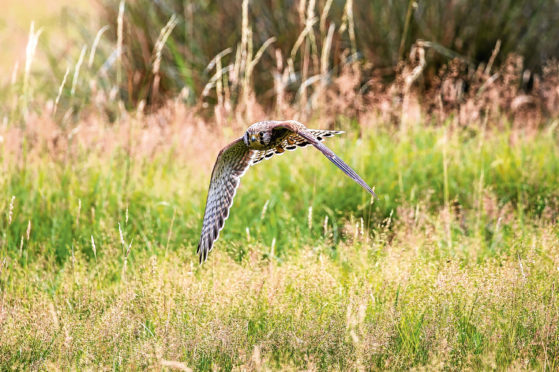A kestrel slips from the crown of an ageing ash tree that appears to have rooted in a singularly steep scree slope halfway up the hill. It side-slips on the air, leading with the open primary feathers of its left wing and eases up to a hovering standstill above a small clearing of grassy hillside amid crowding whin bushes.
Every spring the whins devour more ground. For the kestrel, this means less room for voles and mice, but more nesting terrain for small birds. But the kestrel is a much more efficient voler and mouser than birder so every spring wresting a living from the hillside becomes a little more difficult.
The bird’s dilemma is this. It has a good nest on the flat top of a small rock face overhung (and therefore nicely hidden) by one more whin bush, and it has proved fruitful. So, does it stay put? In which case, does it change its behaviour and try to become a birder, even though the hill also has resident peregrine falcons at the top and sparrowhawks in the big trees at the bottom, and both of these can outfly a kestrel in level flight? Or does it accept that it must hunt further from the nest and that it must carry prey further to reach the nest, and would that make life trickier still? Because if Mr Baker is correct, peregrines target kestrels in the nesting season, which is more or less now. Who’s Mr Baker, I hear you ask? He is – or rather was – J.A. Baker, author of one of the classic texts of English nature writing, The Peregrine, published 50 years ago, a work lauded by nature writers on both sides of the Atlantic and still vigorously in print today.
It includes this: “There is a curious relationship between peregrines and kestrels… The two species are often seen in the same place, especially in autumn and spring… the peregrine may occasionally rob the kestrel of its prey, the kestrel may feed on kills the peregrine has left, the peregrine may attack birds the kestrel unwittingly puts up…By March, the relationship between kestrel and peregrine has changed; the peregrine has become hostile, and will stoop at, and probably kill, any kestrel hovering near…”
If that is true, might the kestrels on this hillside decide to abandon the safe nest site where they have prospered for quite a few springs, take a chance on finding a new nest further along the hillside beyond the sprawl of the whins and beyond the orbit of the peregrines.
Logic says yes but I think no. One of the reasons is that, while there is much to admire in Mr Baker’s book, and the latest edition has a string of celebrity endorsements, there have always been many detractors who simply don’t believe it, not least because he wrote about a great many peregrine falcon sightings in a part of the world – the Essex coast – where almost no-one else was seeing any.
Also, it is a particularly local book, yet he draws generalisations from it, apparently blind to the possibility that the behaviour of his out-on-limb falcons might be the unique product of unique circumstances.
I find myself leaning towards the detractors, and my doubts crept in when I read the passage quoted above. The hillside I have been watching is a radically different piece of terrain from the Essex coast. It is about as far from any coast as you can get in Scotland and it accommodates not just kestrels and peregrines but also sparrowhawks, buzzards and ravens, all within the space of a half-mile-long crag, so they all overlap, and especially at nesting time.
I have never once seen a peregrine stoop at a hovering kestrel, never once seen a peregrine rob a kestrel of its prey, and never once seen a peregrine kill birds put up by a kestrel as it crosses the hillside. That does not mean it never happens but Mr Baker appears to suggest the behaviour is commonplace.
I have, however seen kestrels, both adult and newly fledged, hover on the hillside directly below the peregrine eyrie, many, many times. It’s spring again and, for now, the kestrels and the peregrines haunt the same hillside so there are enough tolerances at work to make it worth the risk.
Writing nature down is an imperfect art. We all witness our own idea of truth, we all like to paint words pictures and atmospheres as well as report what we see. It’s why I like to travel the country – to compare notes, to watch and wonder, to interrogate some of nature’s vast repertoire of possibilities between Highland and Lowland, east or west.
The Peregrine, in its 50th anniversary year, is as startling a book as it ever was. But “the gold standard” of nature writing, to quote one tribute, it is not, for such a beast does not exist.
